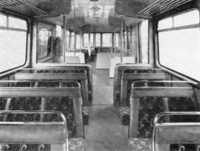AC Cars Railbus
Interior
Seating was in two saloons, one on each side of the centre vestibule. Each saloon had an offset gangway 1 ft. 5 in. wide at seat level increasing to 1 ft. 9 in. above this level due to the narrowing of the seat back. Seat base height was 1' 5" and distance between seat backs was 2' 4".

There were four two-passenger seats of fixed type on one side of the gangway, and four three-passenger seats on the other. The seats in each saloon faced towards the ends of the car. Two additional seats, each accommodating three passengers, occupied the corners beside the driving position. Upholstery was of uncut moquette, supplied by TC Firth (1955) Ltd, with Vynide panels on Dunlopillo bases. Luggage racks (light alloy) and seats were supplied by Dean & Son (Yorkshire) Ltd. Warerite panels were supplied by Bakelite Ltd.
Standard 24v DMU ("bullseye") type lighting fittings supplied by J Stone & Co (Deptford) Ltd were used, spaced to give good illumination, particularly at the doorways.
Vestibule
The entrance sliding doors slid into pockets in the vestibule to eliminate dangers to standing passengers. Both inner and outer walls of the pockets were fitted with glazed sections, the inner one hinged to allow for cleaning the glass. The vestibule was divided from the saloons by panelled partitions, glazed above waist height. Vertical stainless steel pillars at the inner ends of the partition formed a barrier for the glass as well as being grab pillars. A portable extending ladder was strapped to a partition.
Driver's Area
The driver's areas were semi-enclosed, the absence of a door enabled the driver to get quickly to a droplight on the offside of the vehicle for purposes such as to making single line token exchanges. Later folding wooden doors were fitted. The driver's controls consisted of the following:

Speed change and reverse controller
Throttle controler with "Dead Man" connection
Handbrake
Driver's Brake Valve
Engine Speed Indicator
Air Pressure Gauge
Door Control Buttons
Engine Stop and Start Buttons
Light Switches, etc.
Air Operated Horn
Windscreen Wiper
Conventional BUT L-type (Sharps) controls were used, as used on almost all DMUs. Fire extinguishers were carried in vestibules and cabs.
Roller blinds were fitted, at each end of the car, housed in a box formed by the shaping of the roof and ceiling panels.
Summary
Ordering Details
Description: Chassis
Description: Power Train
Description: Suspension
Description: Body
Description: Interior
Numbering & Driving Inst.
Diagrams & Works Photos
Scottish Arrival
Scottish Services Begin
WR Preparations
WR Services Begin
ScR Change & WR Early Years
ScR & WR Moves
All in Scotland
The Final Month
Images
Details about preserved vehicles can be found here.


